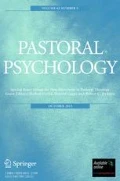Abstract
Religious leaders often experience burnout, which is characterized by emotional exhaustion and/or low satisfaction. Clergy with high emotional exhaustion feel drained and discouraged. Clergy with high satisfaction report that the ministry gives purpose and meaning to their lives. Hierarchichal regression was used to examine if current clergy’s desire to please others, guilt or shame orientation, ability to be self-compassionate, and ability to differentiate self from role uniquely predicted variation in burnout. Although all personality dimensions explained significant variation in emotional satisfaction when examined individually, due to inter-correlations among predictors only self-compassion was significant in the full model. Higher self-compassion was also related to increased satisfaction in ministry. Increasing self-compassion may prevent clergy burnout.
Similar content being viewed by others
References
Beebe, R. (2007). Predicting burnout, conflict management style, and turnover among clergy. Journal of Career Assessment, 15, 257. doi:10.1177/1069072706298157.
Charlton, R., Rolph, J., Francis, L. J., Rolph, P., & Robbins, M. (2008). Clergy work-related psychological health: listening to the ministers of word and sacrament. Journal of Pastoral Psychology, 58, 133–149. doi:10.1007/s11089-008-0177-3.
Cohen, J., Cohen, P., West, S. G., & Aiken, L. S. (2003). Applied multiple regression/correlation analysis for the behavioral sciences (3rd ed.). Mahwah: Lawrence Erlbaum Associates.
Doolittle, B. R. (2008). The impact of behaviors upon burnout among parish-based clergy. Journal of Religion and Health, 49, 88–95. doi:10.1007/s10943-008-9217-7.
Evans, B., & Fischer, D. (1993). The nature of burnout: a study of the three-factor model of burnout in human service and non-human service samples. Journal of Occupational and Organizational Psychology, 66, 29–38.
Francis, L. J., & Rodger, R. (1994). The influence of personality on clergy role prioritization, role influences, conflict and dissatisfaction with ministry. Individual Differences, 16, 947–957. doi:10.1016/0191-8869(94)90237-2.
Francis, L., Louden, S., & Rutledge, C. (2004). Burnout among Roman Catholic parochial clergy in England and Wales: myth or reality? Review of Religious Research, 46, 5–19.
Francis, L., Kaldor, P., Robbins, M., & Castle, K. (2005). Happy but exhausted? Work-related psychological health among clergy. Pastoral Sciences, 24, 101–120.
Francis, L., Wulff, K., & Robbins, M. (2008). The relationship between work-related psychological health and psychological type among clergy serving in the Presbyterian Church (USA). Journal of Empirical Theology, 21, 166–182. doi:10.1163/157092508X349854.
Francis, L., Hills, P., & Kaldor, P. (2009). The Oswald Clergy Burnout Scale: reliability, factor structure and preliminary application among Australian clergy. Journal of Pastoral Psychology, 57, 243–252. doi:10.1007/s11089-008-0165-7.
Francis, L. J., Robbins, M., Rolph, J., Turton, D., & Rolph, P. (2010). The relationship between recalled self-esteem as a child and current levels of professional burnout among Anglican clergy in England. Journal of Pastoral Psychology, 59, 551–561. doi:10.1007/s11089-009-0268-9.
Freudenberger, H. (1974). Staff burnout. Journal of Social Issues, 30, 159–165. doi:10.1111/j.1540-4560.1974.tb00706.x.
Freudenberger, H., & Richelson, G. (1981). Burn-out: The high cost of high achievement. New York: Bantam Books.
Grosch, W., & Olsen, D. (2000). Clergy burnout: an integrative approach. Journal of Clinical Psychology, 56, 619–632. doi:10.1002/(SICI)1097-4679(200005)56:5<619::AID-JCLP4>3.0.CO;2-2.
Hills, P., Francis, L., & Rutledge, C. (2004). The factor structure of a measure of burnout specific to clergy, and its trial application with respect to some individual personal differences. Review of Religious Research, 46, 27–42.
Kaldor, P., & Bullpit, R. (2001). Burnout in church leaders. Adelaide: Openbook.
Leiter, M., & Robichaud, L. (1997). Relationships of occupational hazards with burnout: an assessment of measures and models. Journal of Occupational Health Psychology, 2, 35–44. doi:10.1037/1076-8998.2.1.35.
Lewis, H. (1971). Shame and guilt in neurosis. Psychoanalytic Review, 58, 419–438.
Maslach, C., & Jackson, W. (1981). Maslasch burnnout inventory (Researchth ed.). Palo Alto: CPP, Inc.
Maslach, C., Schaufeli, W., & Leiter, M. (2001). Job burnout. Annual Review of Psychology, 52, 397–422. doi:10.1146/annurev.psych.52.1.397.
Miner, M. (2007). Burnout in the first year of ministry: personality and belief style as important predictors. Mental Health, Religion, & Culture, 10, 17–29.
Miner, M. H., & Downson, M. (2010). Ministry orientation and ministry outcomes: evaluation of a new multidimensional model of clergy burnout and job satisfaction. Journal of Occupational and Organization Psychology, 83, 167–188. doi:10.1348/096317909X414214.
Neff, K. (2003a). The development and validation of a scale to measure self-compassion. Self and Identity, 2, 223–250. doi:10.1080/15298860309027.
Neff, K. (2003b). Self-compassion: an alternative conceptualization of a healthy attitude toward oneself. Self and Identity, 2, 85–101. doi:10.1080/15298860309032.
Neff, K., Kirkpatrick, K., & Rude, S. (2007). Self-compassion and adaptive psychological functioning. Journal of Research in Personality, 41, 139–154. doi:10.1016/j.jrp.2006.03.004.
Oswald, R. M. (1991). Clergy self-care: finding a balance for effective ministry. Herndon: Alban Institute.
Roberts, B. W., Walton, K. E., & Viechtbauer, W. (2006). Patterns of mean-level change in personality traits across the life course: a meta-analysis of longitudinal studies. Psychological Bulletin, 132, 1–25. doi:10.1037/0033-2909.132.1.1.
Rogerson, T. E. & Piedmont, R. L. (1998). Assessing the incremental validity of the religious problem-solving scale in the prediction of clergy burnout. Journal for the Scientific Study of Religion, 37, 517–527.
Rutledge, C., & Francis, L. (2004). Burnout among male Anglican parochial clergy in England: testing a modified form of the Maslach Burnout Inventory. Research in the Social Scientific Study of Religion, 15, 71–93.
Ryan, A. (2006). Clergy morale. The furrow, 57, 677–682.
Sanford, J. (1992). Ministry burnout. Louisville: Westminster John Knox Press.
Stanton-Rich, H., & Iso-Ahola, S. (1998). Burnout and leisure. Journal of Applied Social Psychology, 28, 1931–1950. doi:10.1111/j.1559-1816.1998.tb01354.x.
Tangney, J. P., Stuewig, J., & Mashek, D. J. (2007). Moral emotions and moral behavior. Annual Review of Psychology, 58, 345–372. doi:10.1146/annurev.psych.56.091103.070145.
Turton, D., & Francis, L. (2007). The relationship between attitude toward prayer and professional burnout among Anglican parochial clergy in England: are praying clergy healthier clergy? Mental Health, Religion & Culture, 10, 61–74. doi:10.1080/13674670601012246.
Author information
Authors and Affiliations
Corresponding author
Rights and permissions
About this article
Cite this article
Barnard, L.K., Curry, J.F. The Relationship of Clergy Burnout to Self-Compassion and Other Personality Dimensions. Pastoral Psychol 61, 149–163 (2012). https://doi.org/10.1007/s11089-011-0377-0
Published:
Issue Date:
DOI: https://doi.org/10.1007/s11089-011-0377-0


